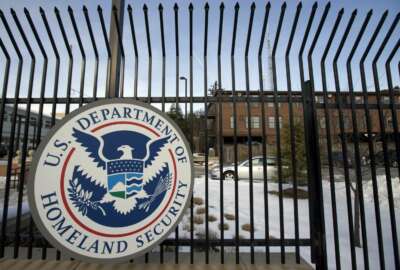

People trying to cross the southern border make most of the news these days. But Customs and Border Protection also apprehends other illegal entrants, those with...
Best listening experience is on Chrome, Firefox or Safari. Subscribe to Federal Drive’s daily audio interviews on Apple Podcasts or PodcastOne.
People trying to cross the southern border illegally make most of the news these days. But U.S. Customs and Border Protection also apprehends illegal entrants, those with four legs, or maybe no legs at all. People constantly attempt to smuggle animals of all sorts into the United States. With how they do it and what happens when they get caught, Federal Drive with Tom Temin spoke with two supervisory CBP agriculture specialists, Ginger Perrone and Robert Ford.
Interview transcript:
Tom Temin: Good to have you both on.
Robert Ford: Thank you. Good to be here.
Ginger Perrone: Thanks for having us.
Tom Temin: Alright, so this interview was prompted by something I read, I think the CBP put out a release that someone had tried to smuggle small birds that were tucked neatly into hair curlers into the United States, and you found those. Tell us how often this happens and what kinds of things you see, Ginger?
Ginger Perrone: There’s actually a seasonality to the finches specifically, where annually in the springtime, we do see an uptick of those particular birds. And part of it’s due to sort of the cultural environment around why they’re being imported. Other forms of wildlife, it’s less seasonal, but specifically the finches that you’re speaking of, it is a sort of recurring.
Tom Temin: I guess the motivation isn’t that important so much as they tried to bring finches in. And are these a species that should not be in the United States the same way you don’t let certain vines and live plants and so forth in?
Ginger Perrone: They’re not endemic to this area. They’re more the tropical species in and of itself. So, they’re not really meant to be in especially the New York area where we see them regularly. But any avian importations come with disease risk. So, it’s not even specific to these species. But, really all live bird importations have risks.
Tom Temin: Yeah. And Robert, what else do you sees from time to time, I guess snakes and that sort of thing? Reptiles?
Robert Ford: Generally here at JFK, I myself have seen a number of giant snails seizures, both aquatic and land snails. Those would both associated with the exotic pet trade. I’ve also seen some very large insects. Rhinoceros beetles, generally speaking, those are about the size of your hand. You’ll see passengers also bring those for exotic pets.
Tom Temin: Wow. So sometimes then the motivation is not so much cultural, with related to springtime events, but a profit motive. They want to sell them here.
Robert Ford: In some cases, yes. In other cases, specifically with the snails, sometimes the intent is for them to be dinner very shortly after their arrival. Other times, they are meant to just be somebody pet too.
Tom Temin: Yeah, so if you want to eat the snails, cook them ahead and then bring them home that way. That’s all right, I guess, right?
Robert Ford: That is the case. Yes.
Tom Temin: And then plants, of course, people try to bring in all the time. Fresh vegetables, and the forms when you fly are pretty clear. You can’t bring in plants, but people do anyway, don’t they?
Robert Ford: For the vast majority of the traveling public, people aren’t trying to break the rules specifically, but everybody wants that piece of home, that taste of home, something to remind them of home, whether it’s a mango that was grown on their property, or whether it’s a piece of the family fig tree to grow here in the U.S. Unfortunately, much like most animals, plants that aren’t intended to be here in the U.S. can very quickly become a problem. Whether they either bring in plant diseases of their own, or bring in plant pests that right along with them. Generally speaking, if it’s not intended to be here, it really is a problem if it arrives here.
Tom Temin: Yes. And we’ve seen some of the issues that can cause plants and animals that get released here. Next thing you know, the Great Lakes are in danger.
Robert Ford: Yes. Something that many people might be more familiar with is the various issues that Florida has with invasive species. Whether it’s various invasive plants in the Everglades, to, again, giant African snails, and even iguanas in South Florida.
Tom Temin: Yikes. We’re speaking with Robert Ford and Ginger Perrone. They are supervisory agricultural specialists at Customs and Border Protection. And Ginger, what happens when you discover something in someone’s luggage? Well, first of all, what gives you the sense they might be smuggling animals in the first place?
Ginger Perrone: As far as live animals, a lot of it’s intelligence based and experience, where it may be we have a tip or there’s known associates or something in that regard. But also with something like the finches, the seasonality of it. We know when it’s more common.
Tom Temin: Sure. Does it tend to be in the luggage or in the carry on? An animal can’t survive in the cargo hold, can it?
Ginger Perrone: I’ve seen both ways. Generally they don’t arrive in great condition, regardless of how they’re being smuggled in. These are very small, somewhat delicate animals. And unfortunately, frequently some do arrive deceased because of the conditions of them being smuggled. So, it’s not any one…one way or the other. It’s kind of a case-by-case basis where it’s hand carried, checked luggage. It can be either.
Tom Temin: Yes. Do you ever get tips or suspicions relayed by flight crews? Maybe somebody tried to feed a little corn into their bag to see what the finches would eat it on the way over.
Ginger Perrone: Not so much something like, oh, we saw them trying to feed them. But, I have gotten [tips] where they’ve been heard. They are live animals and they do tweet. But not so much where they’ve been seen, or the package had been inadvertently opened on the aircraft or something like that. Multiple tips I have gotten.
Tom Temin: Yeah. I guess that’s the advantage of snails. They don’t speak very loudly. And what happens, Robert, when you discover them? What do you do with these animals and critters?
Robert Ford: It kind of depends on what it is that we find. In all regards, they’re initially safeguarded. They won’t be allowed to leave a port of entry. So we can contact veterinary services. And from there, they’ll undergo some sort of quarantine. And after that, they can end up in a number of places. Anywhere from a rescue, or they can be euthanized. So there’s a number of things that could potentially happen to a particular animal that’s being smuggled in.
Tom Temin: Sure. Do people ever try to bring in their own actual pets like dogs and cats? Which I think you can’t just blithely bring over either, correct?
Robert Ford: Yes, people can bring their pets all the time. You would need to contact the USDA, the United States Department of Agriculture. They have rules regarding most pets that you would want to bring with you when entering and leaving the country, and the vast majority require a quarantine of some kind. And it can be generally just some paperwork making sure that they’ve been properly vaccinated. There are means to legally bring your pets into the country.
Tom Temin: Got it. But getting back to the imported things that are not really pets like the snails, those I imagine would be euthanized. Maybe you could drop them into a bucket of vodka, that’d probably be good for a snail, and pickle it at the same time.
Robert Ford: You’re not far off on how that happens. Snails are identified through their shells actually. So there’s no need for the live animal. So, we do have to relax the snail to get the snail to be able to be removed from its shell. So, we do more or less make escargot to get the snail out of the shell so that we can send the shell in for identification. And usually the snail itself is euthanized in the process.
Tom Temin: Yeah, poor thing. And at the major airports that are international, you’re speaking from JFK, but I imagined Atlanta and Miami and a few others, Dallas, does CBP have dedicated facilities to take care of contraband animals and plants?
Ginger Perrone: It varies port by port, sub location, like terminal by terminal. But, we do have dedicated quarantine facilities. We have facilities to dispose of contraband, dedicated spaces to safeguard the live animals to mitigate any risk of escape or potential disease spread or anything like that.
Tom Temin: Alright, and here’s a final question to both of you and Ginger we’ll start with you. What is the strangest living thing that is not plants, let’s say animal, that you’ve ever experienced someone trying to bring in?
Ginger Perrone: The strangest living thing?
Tom Temin: Yeah.
Ginger Perrone: I’d probably have to say some of the varieties of live shellfish. Clams and mussels. Some of them are pretty unusual. Especially even if you’re used to, sort of, prepared Italian dinner style seafood.
Tom Temin: Yeah. Not the kinds of things you’d want to throw into the linguini.
Ginger Perrone: There’s some pretty interesting varieties of shellfish that I’ve come across.
Tom Temin: Okay. And, Robert, what about you?
Robert Ford: I’d have to go back to the giant rhinoceros beetle that I found a few years ago. It’s very disconcerting to run into an insect that’s actually the size of your hand. Loosen a parcel of mail that somebody’s sending to somebody else. It’s very disconcerting to see that when you open the box.
Tom Temin: Yeah, I imagine that’s worse than the tarantula.
Robert Ford: It’s actually bigger than a tarantula. So it’s a very big bug.
Tom Temin: Yeah. You could almost stage had miniature sized King Kong and Godzilla with a tarantula and that rhinoceros beetle maybe sometime, that’s another story. Robert Ford and Ginger Perrone are supervisory agricultural specialists at Customs and Border Protection. Thank you for being on the job so diligently and thanks for this interview.
Robert Ford: Thank you.
Ginger Perrone: Thank you.
Copyright © 2025 Federal News Network. All rights reserved. This website is not intended for users located within the European Economic Area.
Tom Temin is host of the Federal Drive and has been providing insight on federal technology and management issues for more than 30 years.
Follow @tteminWFED


